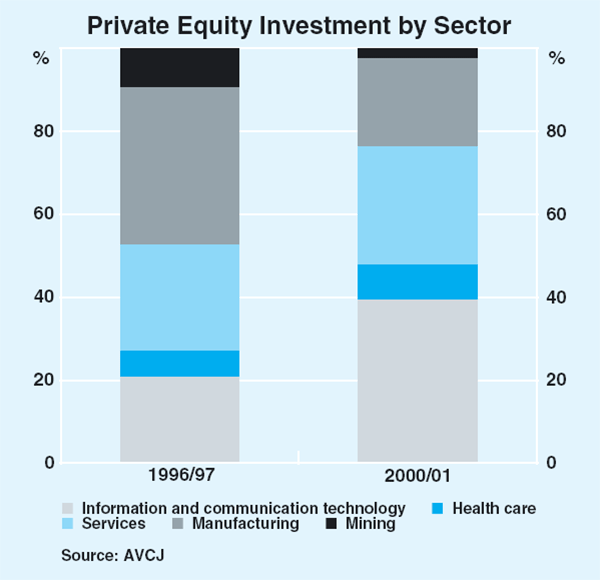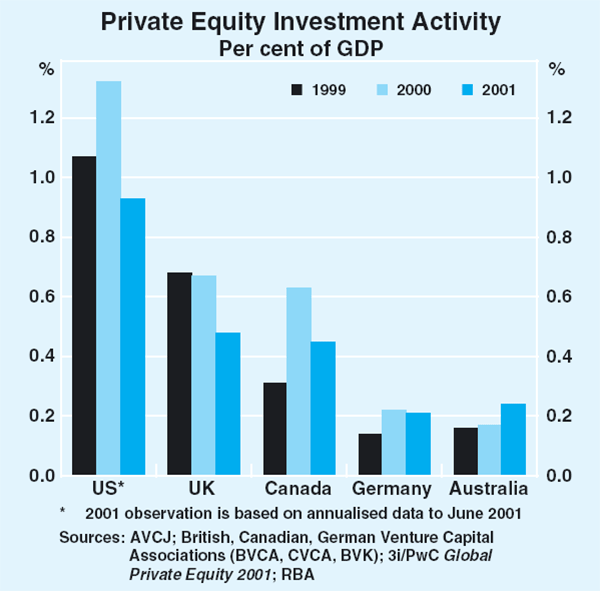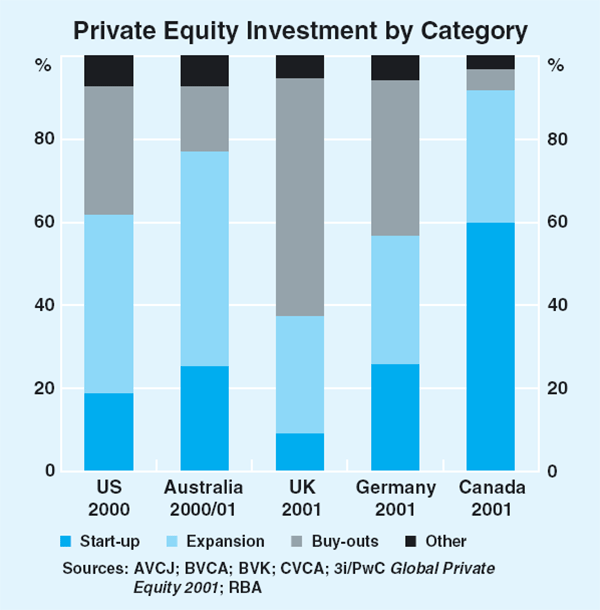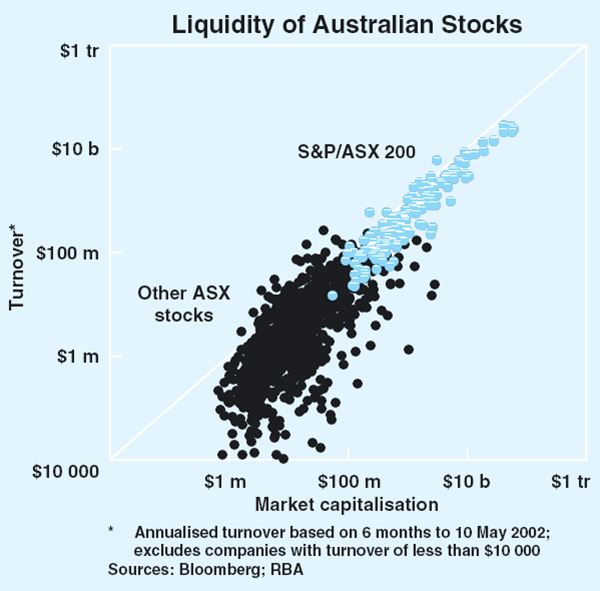Bulletin – June 2002 The Private Equity Market in Australia[1]
- Download 71KB
The Australian private equity market has grown strongly in recent years, driven by demand for funding from small companies and restructuring conglomerates, and a rising supply of funds from institutional investors. While the market remains small compared to other corporate financing sources such as the Australian Stock Exchange (ASX) and bank lending, it potentially plays an important role in improving the overall efficiency of business financing, by providing a source of funding for smaller and riskier companies which may have difficulty in raising funds in other capital markets. This article examines the structure of the market, and considers factors affecting the demand for private equity investment and the supply of funds.
The Definition of Private Equity
Private equity, also known as venture capital, is investment outside of public capital markets. While private equity can be raised from a variety of sources, such as friends, family members and business angels, the more visible (and measurable) avenue is the private equity market where funds are channelled to businesses – typically in new or fast-growing unlisted companies, or companies in financial difficulty with potential for restructuring – by fund managers.
Private equity funding in this market can be broken up into various categories:
- start-up financing for a business less than 30 months old where funds are required to develop the firm's products;
- expansion financing, where additional funds are required to manufacture and sell products commercially;
- turnaround financing for a company in financial difficulty; and
- management buy-out (MBO) financing, where a business is purchased by its management team with the assistance of a private equity fund.
Businesses tapping the private equity market often do not have sufficient collateral or a track record of profits to obtain bank financing. At the same time, private equity fund investors reduce the information asymmetries that may exist between investors and companies looking for finance, thereby lowering the cost of capital for small companies. The investment horizon for a private equity investor is usually between five to ten years. Exits are normally achieved by listing on the stock exchange, usually through an initial public offering (IPO), or by the writing-off or sale of investments.
Size and Structure of the Market
The Australian Bureau of Statistics (ABS) estimates that $5.7 billion was committed to the private equity market as at June 2001, of which $3.7 billion was drawn down; gross inflows amounted to $900 million in 2000/01. By way of comparison, the net flow of debt and listed equity to business in the year to June 2001 was $24 billion and $12 billion respectively. The Australian Venture Capital Journal (AVCJ) estimate of the size of the market is somewhat larger as the AVCJ uses a broader definition that incorporates, inter alia, longer-term commitments and investments in New Zealand. It estimates that gross inflows amounted to $1.7 billion (over 0.2 per cent of GDP) in calendar 2001, compared with gross inflows of $400 million (less than 0.1 per cent of GDP) in 1996.
According to the ABS, at June 2001 there were around 150 private equity funds active in Australia that invested in over 800 companies. The AVCJ estimates that the average size of new investments in 2000/01 ranged from $1.5 million for start-up investments, to around $14 million for MBOs (Table 1). Start-up and expansion investments constituted almost 80 per cent by value of Australian private equity funding. According to the ABS, private equity funding was difficult to obtain: in 2000/01, 270 companies received private equity funding for the first time, from over 19,000 applicants.
| Number of investments |
Total value $ m | Average size $ m | |
|---|---|---|---|
| Start-up | 241 | 352 | 1.5 |
| Expansion | 261 | 712 | 2.7 |
| Turnaround | 9 | 23 | 2.6 |
| Buy-outs | 16 | 220 | 13.8 |
| Other | 14 | 74 | 5.3 |
| Total | 541 | 1,381 | 2.6 |
|
Source: AVCJ |
|||
In 2000/01, private equity investment was concentrated in the information and communication technology (ICT) and services industries (Graph 1). Investments in the ICT industry doubled as a proportion of new private equity investment, to around 40 per cent between 1996/97 and 2000/01. This has been offset by declines in the share of investment in the manufacturing and mining industries. The share of private equity investment in health care (including bio-sciences) and services has increased slightly.

Private equity funds obtain their funding commitments primarily from Australian institutional investors. In June 2001, almost half of the funding was sourced from Australian superannuation funds and life offices (Table 2). Governments provided 12 per cent of the funding, with Federal and State governments investing in private equity through a range of programs. Foreign investors committed around 10 per cent of funds at June 2001, which is quite low in comparison with Germany and the UK, but is broadly consistent with the fairly low level of foreign investment in Australian portfolio equity over this period.
| Share in June 2000 |
Share in June 2001 |
|
|---|---|---|
| Residents | ||
| Superannuation funds | 35.8 | 41.9 |
| Government | 2.4 | 12.3 |
| Life insurance offices | 3.7 | 6.7 |
| Banks | 6.8 | 3.8 |
| Trading enterprises | 9.7 | 4.4 |
| Other residents | 20.9 | 20.4 |
| Foreign investors | 20.7 | 10.5 |
|
Source: ABS |
||
Despite the strong growth over the past few years, Australia's private equity market is still smaller than those in North America and the UK when measured as a share of GDP (Graph 2). To a large extent this reflects sizable private equity investments around the turn of the decade in technology-related firms in these regions. In the US, for example, at the peak of the technology boom around 70 per cent of private equity investment was in ICT firms. The Australian private equity market is also much younger than comparable markets in North America and Europe which were quite active in the late 1980s, particularly in management buy-outs. In comparison with other countries, a large amount of private equity investment in Australia relates to financing for expansion of existing businesses (Graph 3).


Why Companies use Private Equity Funding
The private equity market mainly attracts small companies with limited access to internal funds or bank loans. These companies normally have insufficient collateral and/or no track record of profits to support bank borrowings or debt raisings. In cases where debt financing is available, it may be relatively expensive. For example, as at December 2001, around 11 per cent of business loans of under $500,000 were charged an interest rate of 10 per cent or more, compared with 3 per cent of business loans of $500,000 or more.
There are also impediments to listing on the share market. For small companies the costs associated with listing as a public company, such as the legal and accounting costs involved in the provision of semi-annual public financial statements, annual auditing, and complying with the ASX's continuous disclosure requirements, can be substantial.
The liquidity of the stocks of large listed companies tends to be considerably higher than that of smaller listed companies, which may make capital raisings for small business more expensive. This may discourage small firms from seeking listings, and encourages some small listed companies to delist and seek private equity funding instead. As evidence of this, the liquidity of stocks can be measured by taking the ratio of turnover to market capitalisation. If small companies were as liquid as large companies, then the value of turnover of stocks would increase proportionally with an increase in market capitalisation. Instead, for the population of Australian stocks, large companies are significantly more liquid than small companies (Graph 4).

The lack of liquidity for small companies may reflect the relative importance of institutional investors who tend to focus on large listed corporates. In the US, for example, there is a body of literature which suggests that large companies trade at a premium to small companies, making capital raising more expensive for small companies. For instance, Gompers and Metrick[2] report a significant premium for large companies of which they attribute nearly half to the demand for their stocks from institutional investors. In Australia, such a premium may have been reduced through the development of small-cap indices, such as the ASX Small Ordinaries index, to the extent that these indices are followed by institutional investors. However, the companies in these indices are much larger than the smallest companies in the market. For instance, the Small Ordinaries index includes the ASX's 100th to 300th largest companies, out of over 1,300 Australian companies listed on the exchange.
Companies can gain from the expertise that private equity funds bring to the management of fast growing start-ups and the restructuring of poorly performing companies. While private equity funds tend not to take a controlling stake, they are typically represented on the board of the investee company, thereby providing management advice and specific performance targets.[3]
Demand for private equity funding has also risen as the number of management buy-outs has increased. These either involve the sale of the subsidiaries of industrial conglomerates, or public-to-private transactions. Several Australian public companies, for example, have sold non-core subsidiaries to private equity consortiums as a means of consolidating their businesses. In a public-to-private transaction, the management of a thinly traded or undervalued public company may be invited by a private equity fund to participate in the purchase and delisting of the company. The company can then embark on an expansion program or increase its leverage beyond the levels that might be tolerated by the shareholders of public companies. According to the AVCJ, MBOs as a share of private equity investment almost doubled in 2001 to 36 per cent, with competitors and other trade buyers less willing to purchase companies during an uncertain global economic climate. These MBOs have tended to be in more mature industries such as manufacturing and mining, where there are steady cash flow streams that can service the higher borrowings that are associated with this type of transaction.
Investors have been attracted to private equity by the prospect of high returns, as well as potential diversification benefits. However, the returns are very volatile, with returns on funds formed since 1998 quite low, possibly due to the large proportion of investment in ICT firms.
Footnotes
This article was prepared by Ellis Connolly, Economic Analysis Department, and Alvin Tan, Domestic Markets Department. [1]
Gompers P and A Metrick (2001), ‘Institutional investors and equity prices’, Quarterly Journal of Economics, 116 (1), pp 229–259. [2]
According to the ABS, in 80 per cent of cases individual private equity funds have less than 40 per cent equity in the target company. [3]